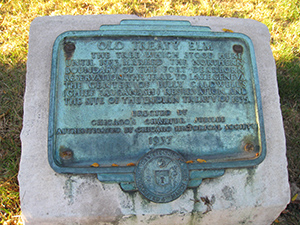Sauganash History
CHECK OUT OUR HISTORY GALLERY!
Billy Caldwell was born in 1782 of a Mohawk mother and an Irish father, William Caldwell, Sr., a Captain of the British Butler Rangers. He acquired the nickname “Sauganash,” an Indian word meaning “English-speaking” or “Englishman”. In recognition of his services to the U.S. in helping negotiate the 1829 Prairie du Chien Treaty, Billy Caldwell was rewarded the same year with a 1,600-acre land patent along both sides of the Chicago River—crucial for food, water, and transportation—which accounts for our diagonal street pattern. Indian trail, now Caldwell Ave., started at the center of the Reservation and was the main route to Big Foot Lake, now known as Lake Geneva. Caldwell began selling off the land in 1833.
In 1840, Charles Johnson arrived from Sweden and purchased part of this land, building a farmstead near the corner of Peterson and Cicero Avenues where it remained into the early 1950’s. In 1912 a small portion of the Billy Caldwell Reserve, 260 acres, was purchased by the real estate firm Koester and Zander and named “Sauganash.” It is suspected that the firm created the “Treaty Elm” story and installed the plaque to enhance the appeal of Sauganash.
Construction of the first eight homes on Kostner Avenue between Peterson and Rogers Avenues began in 1923 and they were completed the following year. Home construction was brisk with the first hundred homes built and occupied by 1928, and another hundred homes were completed by 1930.




















